Are you a Quiet Speculation member?
If not, now is a perfect time to join up! Our powerful tools, breaking-news analysis, and exclusive Discord channel will make sure you stay up to date and ahead of the curve.
It seems that the more things change, the more they stay the same and for Modern that means that Affinity is a tier 1 deck again. Affinity is one of the longest-standing decks in Modern and one of the biggest surprises about that statement is that Affinity has not gained much in the last two years or so. Affinity continues to push other decks out of tier 1 status while putting copies into the top of tournaments all over the world. So, what is it that keeps this deck at the top tables and why are other major decks unable to hate out this well-known strategy?
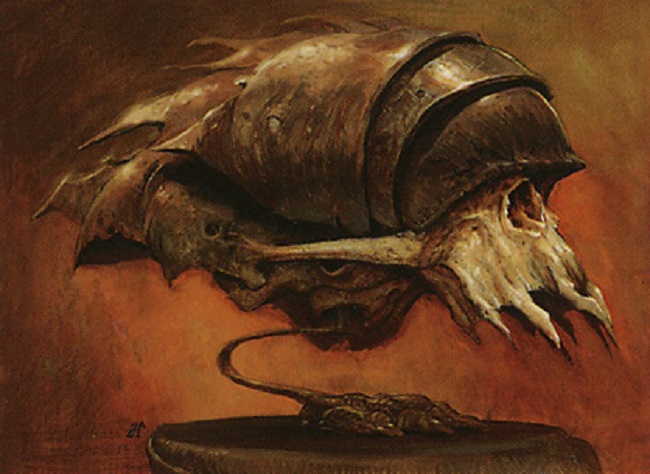
One of the biggest factors contributing to Affinity’s longevity and continued Modern dominance is that Affinity’s best draws are nearly unbeatable for most decks. As opposed to most tier 1 decks like Twin, Abzan or Jund, Affinity threatens the opponent as early as turn one with the ability to ramp out powerful two-mana threats or to simply drop their whole hand. This puts opposing decks under heavy pressure and often forces players to fetch and shock on turn one to survive against Affinity's openings. Of course, this just helps Affinity’s clock. In addition, when Affinity drops a lot of cards on turn one and then resolves a turn two Cranial Plating, the game often feels over.
This ability to warp the tempo of the game and create situations where a reasonable hand kept in the dark just dies to an Affinity pilot on the play is easily the robots' biggest advantage.
[wp_ad_camp_1]
Difficult but Rewarding
Another major benefit Affinity has compared to many decks aggressive Modern decks is that there is nearly no skill ceiling. Affinity's lines of play and arching decision trees will always reward higher-skilled players.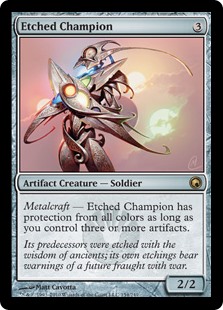 Compare this to decks such as Burn, which tend to have a lower skill ceiling because you have fewer decisions throughout the game, even if many of those decisions are very important. Affinity can outmaneuver almost any deck when piloted correctly. While Affinity aims to kill around turn four, its ability to grind down an opponent who stalls with removal is very strong and rare for aggressive decks in Modern. Cards like Etched Champion, Blinkmoth Nexus, and Blinkmoth Nexus go a long way towards this end. Unlike Affinity, the majority of aggressive decks in Modern are overly linear with fewer choices and decision trees. This difference is a big reason why aggressive decks wane in certain metas, but Affinity normally does not.
Compare this to decks such as Burn, which tend to have a lower skill ceiling because you have fewer decisions throughout the game, even if many of those decisions are very important. Affinity can outmaneuver almost any deck when piloted correctly. While Affinity aims to kill around turn four, its ability to grind down an opponent who stalls with removal is very strong and rare for aggressive decks in Modern. Cards like Etched Champion, Blinkmoth Nexus, and Blinkmoth Nexus go a long way towards this end. Unlike Affinity, the majority of aggressive decks in Modern are overly linear with fewer choices and decision trees. This difference is a big reason why aggressive decks wane in certain metas, but Affinity normally does not.
Affinity also has one of the best qualities of a deck for any open tournament: punishing an opponent's poor draws. In larger tournaments, it is very important to be able to close out a game quickly when your opponent misses on mana for a turn or cannot find a threat that matters. If you give your opponent time, they can come back. This is frequently a problem for slow, powerful decks such as UW Control. On the other hand, the average Affinity hand will punish any missteps and end the game quickly. Free wins are a real reason to play this deck in large tournaments as they allow you to take matches with ease and give your mind some time to rest in between rounds. This is important for a deck like Affinity that often takes a lot of mental energy and math.
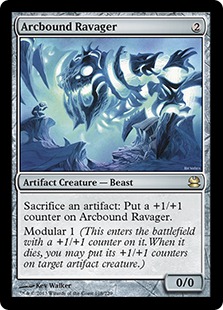 We can also look at the interactions between specific Affinity staples to help us see another big reason the deck weathers most storms. Arcbound Ravager, Blinkmoth Nexus, Steel Overseer, andSignal Pest all create situations where the opponent’s answers have to line up perfectly with your diverse threats. If they don't, opponents fall too far behind. Arcbound Ravager makes spot removal, especially Lightning Bolt, much weaker by eating Bolt targets and growing other threats out of burn range. In addition, Ravager can change race situations with Blinkmoth Nexus, suddenly powering out a 10/10 flying, infect creature opponents cannot beat. Of course, choosing what to eat and when is the hard part. Knowing when to "go all in" makes Ravager one of the hardest cards to play optimally in the format, but its many decision trees reward higher skilled players while punishing inexperienced pilots.
We can also look at the interactions between specific Affinity staples to help us see another big reason the deck weathers most storms. Arcbound Ravager, Blinkmoth Nexus, Steel Overseer, andSignal Pest all create situations where the opponent’s answers have to line up perfectly with your diverse threats. If they don't, opponents fall too far behind. Arcbound Ravager makes spot removal, especially Lightning Bolt, much weaker by eating Bolt targets and growing other threats out of burn range. In addition, Ravager can change race situations with Blinkmoth Nexus, suddenly powering out a 10/10 flying, infect creature opponents cannot beat. Of course, choosing what to eat and when is the hard part. Knowing when to "go all in" makes Ravager one of the hardest cards to play optimally in the format, but its many decision trees reward higher skilled players while punishing inexperienced pilots.
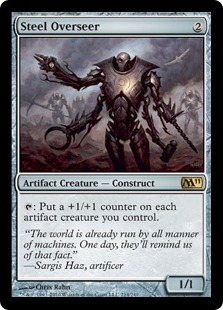 Steel Overseer and Signal Pest demonstrate another strength of the Affinity deck: its ability to go wide quickly with big payoffs. Cards like Ornithopter, Vault Skirge, and Memnite require some support to make them worth playing, as they are quite underpowered on their own. Signal Pest and Steel Overseer, along with Master of Etherium, pump these smaller creatures, rewarding you for playing synergistic cards. Left unchecked, they will just take over the game, which is a big issue for opponents who don't (or can't) answer them. They also often require different sets of answers. Signal Pest cannot usually be traded with through creatures, Overseer requires immediate burn or removal, and Master will usually demand a hard removal spell to kill at all. The ability to play a very aggressive game, one bolstered with must-answer threats like Overseer and Ravager, creates an absurd amount of pressure for your opponents.
Steel Overseer and Signal Pest demonstrate another strength of the Affinity deck: its ability to go wide quickly with big payoffs. Cards like Ornithopter, Vault Skirge, and Memnite require some support to make them worth playing, as they are quite underpowered on their own. Signal Pest and Steel Overseer, along with Master of Etherium, pump these smaller creatures, rewarding you for playing synergistic cards. Left unchecked, they will just take over the game, which is a big issue for opponents who don't (or can't) answer them. They also often require different sets of answers. Signal Pest cannot usually be traded with through creatures, Overseer requires immediate burn or removal, and Master will usually demand a hard removal spell to kill at all. The ability to play a very aggressive game, one bolstered with must-answer threats like Overseer and Ravager, creates an absurd amount of pressure for your opponents.
Now that we have talked about a lot of the individual stars from the main deck of Affinity, let us look at an average list of Affinity from a Magic Online daily that went 4-0.
"Stock Affinity"
Notable role players that help keep Affinity in the driver’s seat are Spellskite, Springleaf Drum, and Mox Opal. Spellskite allows the Affinity player to defend whatever card is most important to winning any particular game, often Cranial Plating, Steel Overseer, and your two manlands, while itself synergizing with the rest of the deck. Mox Opal and Springleaf Drum allow you to accelerate into more threats on turn one or have access to three mana on turn two. In turn, this lets you cast and equip Cranial Plating, or just drop Etched Champion as an early evasive threat. They also let you run a much lower land count than other Modern decks.
The Sideboard Trap
 One of the biggest reasons Affinity continues to succeed is its diverse and effective sideboard. That said, this returns us to an earlier point about the deck rewarding high-skill pilots: over-sideboarding slows the deck down but under-sideboarding can leave you dead to cards like Stony Silence or Night of Souls' Betrayal. Affinity experts need to balance these tensions. Some all-star cards in current Affinity sideboards are Blood Moon, Ghirapur Aether Grid, Spell Pierce, and Thoughtseize, which all help steal percentage points back in tough matchups. Blood Moon can snipe wins versus various three-color decks and shut down land-based combo decks like Bloom Titan. Ghirapur Aether Grid allows Affinity to fight through the powerful Stony Silence and turn otherwise dead cards such as Springleaf Drum and Mox Opal into damage dealers. Thoughtseize and Spell Pierce allow the deck to take on a more aggro-control role post-board, letting you apply pressure while holding countermagic against the sweeping sideboard cards many players will have for Affinity.
One of the biggest reasons Affinity continues to succeed is its diverse and effective sideboard. That said, this returns us to an earlier point about the deck rewarding high-skill pilots: over-sideboarding slows the deck down but under-sideboarding can leave you dead to cards like Stony Silence or Night of Souls' Betrayal. Affinity experts need to balance these tensions. Some all-star cards in current Affinity sideboards are Blood Moon, Ghirapur Aether Grid, Spell Pierce, and Thoughtseize, which all help steal percentage points back in tough matchups. Blood Moon can snipe wins versus various three-color decks and shut down land-based combo decks like Bloom Titan. Ghirapur Aether Grid allows Affinity to fight through the powerful Stony Silence and turn otherwise dead cards such as Springleaf Drum and Mox Opal into damage dealers. Thoughtseize and Spell Pierce allow the deck to take on a more aggro-control role post-board, letting you apply pressure while holding countermagic against the sweeping sideboard cards many players will have for Affinity.
The Matchups
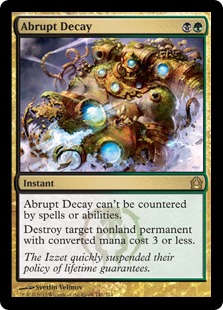 The BGx matchup, especially Abzan, can be a struggle for the average Affinity draw. Their combination of cheap efficient creatures and removal makes the matchup feel like a race, but one where the BGx decks have cards like Lingering Souls, Lightning Bolt, and Tarmogoyf to swing the battle. The bad news is that Affinity cannot match the individual cardpower of Abzan or Jund, and both have tools to fight Affinity after board. The good news is that BGx decks suffer from having many fetchlands that want to find shocklands. This helps Affinity get there with weaker hands that can only deal 14 damage. Much like Burn, Affinity takes advantage of the punishing Modern manabase, only it seeks to punch through for single massive attacks rather than wear you down with burn spells. The keys to victory, especially against BGx, are experience and smart sideboarding. Overall, although Abzan and Jund can beat Affinity (especially postboard with Silence and Ancient Grudge), Affinity players well-versed in their deck can weave through the matchup and take down many closer games.
The BGx matchup, especially Abzan, can be a struggle for the average Affinity draw. Their combination of cheap efficient creatures and removal makes the matchup feel like a race, but one where the BGx decks have cards like Lingering Souls, Lightning Bolt, and Tarmogoyf to swing the battle. The bad news is that Affinity cannot match the individual cardpower of Abzan or Jund, and both have tools to fight Affinity after board. The good news is that BGx decks suffer from having many fetchlands that want to find shocklands. This helps Affinity get there with weaker hands that can only deal 14 damage. Much like Burn, Affinity takes advantage of the punishing Modern manabase, only it seeks to punch through for single massive attacks rather than wear you down with burn spells. The keys to victory, especially against BGx, are experience and smart sideboarding. Overall, although Abzan and Jund can beat Affinity (especially postboard with Silence and Ancient Grudge), Affinity players well-versed in their deck can weave through the matchup and take down many closer games.
Linear aggressive decks like Merfolk and slower value centric decks like Grixis, despite having cards that are good in the matchup, are not favored against Affinity. Neither deck can deal with Affinity's multiple angles of attack. Merfolk-style decks are too slow to race Affinity but also lack the removal to stay in the game. This forces them to draw their sideboard hate early or die.
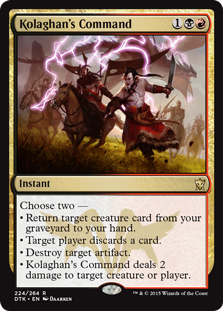 Grixis can be difficult if it has a removal-heavy draw, but hands with too much countermagic rarely pan out and delve creatures do not match up well with the Affinity package. The matchup is still very close, but Affinity often has the advantage against Grixis control, even if it is a slight underdog to the less-played Grixis Delver. True, Grixis Control has cards that are hard to deal with, such as Kolaghan's Command and Lightning Bolt. Skilled Affinity players can navigate around this, dealing a lot of damage quickly and closing the game out with evasive threats like Blinkmoth Nexus or Etched Champion, all the while baiting important cards and putting Grixis under immediate pressure. Grixis' lack of lifegain and painful mana also help. While the matchup feels close pre-board, Thoughtseize, Spell Pierce, and Spellskite make it hard for Grixis to answer Affinity’s threats cleanly.
Grixis can be difficult if it has a removal-heavy draw, but hands with too much countermagic rarely pan out and delve creatures do not match up well with the Affinity package. The matchup is still very close, but Affinity often has the advantage against Grixis control, even if it is a slight underdog to the less-played Grixis Delver. True, Grixis Control has cards that are hard to deal with, such as Kolaghan's Command and Lightning Bolt. Skilled Affinity players can navigate around this, dealing a lot of damage quickly and closing the game out with evasive threats like Blinkmoth Nexus or Etched Champion, all the while baiting important cards and putting Grixis under immediate pressure. Grixis' lack of lifegain and painful mana also help. While the matchup feels close pre-board, Thoughtseize, Spell Pierce, and Spellskite make it hard for Grixis to answer Affinity’s threats cleanly.
On the other side of the coin, Grixis Delver can fight your game plan with the same cards as Grixis Control, but also apply its own pressure early. Their tempo plan can simply slip past Affinity's synergistic offense. However, the biggest advantage Affinity has is that even Grixis Delver cannot easily deal with fliers outside of Bolt and Command. Grixis can definitely brickwall the ground with Tasigur, the Golden Fang and Gurmag Angler, but the air is usually clear. If they're blocking with Delver, it's good for you. If not, Affinity can go wide and win the damage race. While it is not impossible to lose to hate or bad draws, Affinity certainly has teeth in the matchup.
Against decks like UW Control and other traditional control decks with Spell Snare and sweepers, Affinity can struggle. It cannot usually play around sweepers and rarely has the burn to finish off opponents after losing its board. These decks also have lots of lifegain and sideboard hate. Luckily, decks of this nature are not particularly prevalent nor tier 1, at least yet.
The Twin Problem
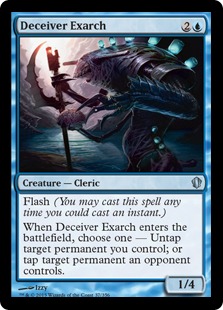 Twin, especially UR Twin, has long been seen as a poor matchup for Affinity and its absence is seen as a reason for Affinity's recent dominance. This evaluation isn't wrong, but I believe that Twin is a more card-dependent matchup than many realize. Thanks to their interactive elements, Twin's kill is often faster. If they can resolve the combo, you have exactly four Galvanic Blasts to break it up in game one. Post-board you have a more answers, but Twin will be bringing in its own dedicated hate. Twin is one of the harder matchups for Affinity of the top tier decks as waiting until turn five to play Splinter Twin with Dispel backup can usually get the job done, even if the disruption plan is not enough. To win, the Affinity player must put the Twin pilot under enough pressure to force a combo on turn four with no protection. In that situation, Affinity can take down the game. The best plan for Affinity is to simply play as aggressively as possible and force Twin to combo or die.
Twin, especially UR Twin, has long been seen as a poor matchup for Affinity and its absence is seen as a reason for Affinity's recent dominance. This evaluation isn't wrong, but I believe that Twin is a more card-dependent matchup than many realize. Thanks to their interactive elements, Twin's kill is often faster. If they can resolve the combo, you have exactly four Galvanic Blasts to break it up in game one. Post-board you have a more answers, but Twin will be bringing in its own dedicated hate. Twin is one of the harder matchups for Affinity of the top tier decks as waiting until turn five to play Splinter Twin with Dispel backup can usually get the job done, even if the disruption plan is not enough. To win, the Affinity player must put the Twin pilot under enough pressure to force a combo on turn four with no protection. In that situation, Affinity can take down the game. The best plan for Affinity is to simply play as aggressively as possible and force Twin to combo or die.
While Affinity continues to play at the top tables of many Modern events, it does require a very high level of play and focus to do well in larger tournaments. Another aspect of Affinity that newer players struggle with is understanding when to slow down and hold answers to specific hate cards such as Creeping Corrosion or Stony Silence. In addition, many players at large events will come with excessive sideboard hate for a deck such as Affinity. If the Affinity player does not play around them properly, it's easy to hate out the deck.
I believe Affinity is a strong strategy for most tournaments and is a deck where the more proficient you become, the more wins you will earn. Affinity continues to exist at the top tables as it continues to win free games and put massive pressure on opponents, many of whom cannot answer Affinity's level of aggression. For these reasons, it will continue to stay at the top tables for a very long time to come.




Excellent profile on Affinity. I think all of your matchup assessments and strategy advice was on point, and I think that this article is a valuable resource for someone getting started on the deck (so much so that I’m sending it to someone I know that fits the profile).
However, I’d like to hear your thoughts on Thoughtcast. I know it’s not in your deck at the moment, but it has the potential to ameliorate the UW matchup by giving you a bit of bounce-back ability after a sweeper (especially when you have a couple of Mox Opals and the like lying around). Would you say that it’s good to keep it in mind, or has the meta passed it by?
Thanks for writing the primer.
I am an affinity pilot. I have pilot it for almost a year. Your analysis is rather correct. But comparing jund and abzan, affinity tends to have a harder time against abzan more than jund due mainly to lingering souls and their ability to bring in stony silence. UW is almost a natch that we give away. To said the truth, deck that runs white posed more of a problem than other colour. The 2 hate card kataki and stony silence casted on turn 2 is almost certain loss to affinity. Also, affinity have to mulligan aggressively. Roland mentioned about thoughtcast which is a good card, however, in current context, galvanic blast is more relevant. If you have noticed the trend, affinity is shifting from blue to red. Etched champion and spellskite that used to be in sideboard had become mainboard. Wit mirror match being more common, an opposing spellskite can spell trouble. Thus is where galvanic blast prove to be more important than thoughtcast. Also thoughtcast seldom are able to bring us back into the game after a boardwipe. Therefore, the shift . Many affinity player argued about running steel overseer because it is the weakest link in a meta full of removal. But fail to see how it can provide value after 1-2 activation. Also serving as lightning rod for removal means cranial plating and arcbound ravager is safe from certain death. Tron is a match-up you didn’t mentioned. I usually don’t like the tron match-up ad it really depends on how fast in your hand and how fast they can assemble tron. I will prefer using the infect win against tron as it is the fastest we can go without disruption.
“Affinity is one of the longest-standing decks in Modern and one of the biggest surprises about that statement is that Affinity has not gained much in the last two years or so.”
This is somewhat misleading, as Affinity, like Burn, is a deck whose very nature of being built around core game mechanics puts it in a strong position to receive new good cards from any expansion. While it is true that Scars of Mirrodin was the last set to offer up a significant number of cards, in the meantime we have had Ensoul Artifact and Ghirapur Æther Grid which have both been incredible cards for Affinity. While I don’t see this getting a heaping pile of new cards during BfZ Block or Shadows Block, I do think the likelihood of one or two powerhouse cards being spoiled in that time is much higher for Affinity than it is for most decks.